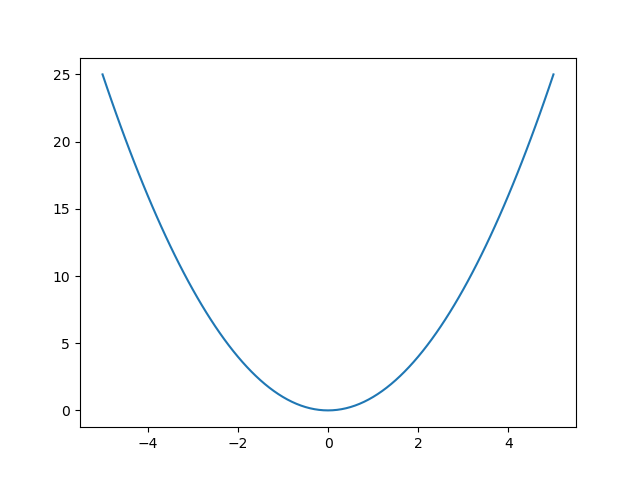背景
第三弾になりますが、タイトル通り入門編として記載します。
最適化問題とは
簡単に言うと、ある定義された関数の最小を導く問題です。
定義関数例
簡単な2次関数にします。
def f(x):
return x**2
分かりやすく描画します。
import matplotlib.pyplot as plt
import numpy
x = numpy.arange(-5, 5.1, 0.1)
plt.plot(x, f(x))
plt.show()
はい、とってもシンプルな例です。
定義注意
最適化問題の関数はscipyに含まれています(事前にインストールしてください)
ここで一点注意、普通にimport定義すると怒られます。
import scipy
scipy.optimize
Traceback (most recent call last):
File "<stdin>", line 1, in <module>
AttributeError: 'module' object has no attribute 'optimize'
scipy.optimizeを使うには、公式サイトにも書いてありますが
from scipy import optimize
と定義しましょう。
最適化
一般的な滑降シンプレックス法、Nelder–Mead法で行います。
こちらはscipyではscipy.optimize.fmin関数が該当します。
この関数何だっけ?使い方どうするんだっけ?という場合はnumpy.infoで確認できます。
import numpy
from scipy import optimize
numpy.info(optimize.fmin)
fmin(func, x0, args=(), xtol=0.0001, ftol=0.0001, maxiter=None, maxfun=None,
full_output=0, disp=1, retall=0, callback=None, initial_simplex=None)
Minimize a function using the downhill simplex algorithm.
This algorithm only uses function values, not derivatives or second
derivatives.
Parameters
----------
func : callable func(x,*args)
The objective function to be minimized.
x0 : ndarray
Initial guess.
args : tuple, optional
Extra arguments passed to func, i.e. ``f(x,*args)``.
xtol : float, optional
Absolute error in xopt between iterations that is acceptable for
convergence.
ftol : number, optional
Absolute error in func(xopt) between iterations that is acceptable for
convergence.
maxiter : int, optional
Maximum number of iterations to perform.
maxfun : number, optional
Maximum number of function evaluations to make.
full_output : bool, optional
Set to True if fopt and warnflag outputs are desired.
disp : bool, optional
Set to True to print convergence messages.
retall : bool, optional
Set to True to return list of solutions at each iteration.
callback : callable, optional
Called after each iteration, as callback(xk), where xk is the
current parameter vector.
initial_simplex : array_like of shape (N + 1, N), optional
Initial simplex. If given, overrides `x0`.
``initial_simplex[j,:]`` should contain the coordinates of
the j-th vertex of the ``N+1`` vertices in the simplex, where
``N`` is the dimension.
Returns
-------
xopt : ndarray
Parameter that minimizes function.
fopt : float
Value of function at minimum: ``fopt = func(xopt)``.
iter : int
Number of iterations performed.
funcalls : int
Number of function calls made.
warnflag : int
1 : Maximum number of function evaluations made.
2 : Maximum number of iterations reached.
allvecs : list
Solution at each iteration.
こんな形で引数や出力、この関数の意味など詳細が確認できます。
では最適化します。
optimize.fmin(f, 1)
Optimization terminated successfully.
Current function value: 0.000000
Iterations: 18
Function evaluations: 36
array([-1.77635684e-15])
最小値は-1.77635684e-15と算出されました。
他の内容はその時の関数の値、最適化時のイテレーション回数や関数の回数等です。
補足
「ある範囲内」という場合はoptimize.fminboundという関数もあります。
optimize.fminbound(f, 2, 3, full_output=1)
(2.000005960860986, 4.000023843479476, 0, 25)
そもそもですが、一次関数程度ならoptimize.brentという関数も存在します。
optimize.brent(f, brack=(1,2), full_output=1)
(0.0, 0.0, 4, 5)
もっともっというと、optimize.minimizeという関数が存在します。
optimize.minimize(f, 1.0, method='Nelder-Mead')
final_simplex: (array([[-8.8817842e-16],
[ 9.7656250e-05]]), array([7.88860905e-31, 9.53674316e-09]))
fun: 7.888609052210118e-31
message: 'Optimization terminated successfully.'
nfev: 34
nit: 17
status: 0
success: True
x: array([-8.8817842e-16])
minimizeの公式ドキュメントを見ると、他にも様々な手法が可能です。
以上で最適化問題の入門編ということで終わりにします。
